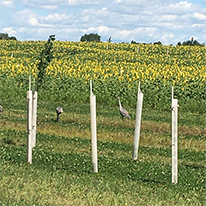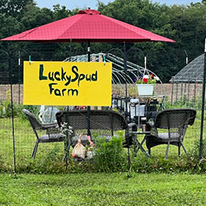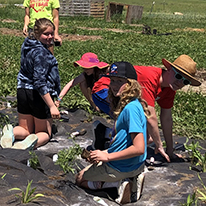Those broadly spaced rows of saplings you see to the right as you enter the Silverwood Park? That is alley cropping, broadly defined as planting rows of trees or shrubs at wide spacings, creating alleys between them where annual agricultural crops are cultivated. Other terms for alley cropping include intercropping and multi-cropping. Alley cropping is just one example of the practices covered by the collective term agroforestry. Any farming where woody perennials are used on the same land as agricultural crops or animals is a form of agroforestry.
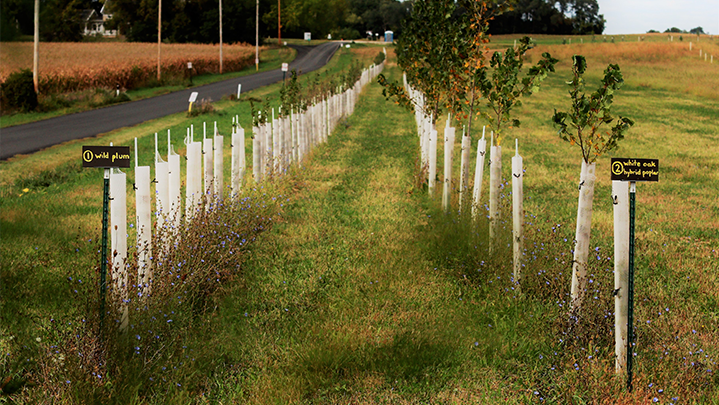
Photo by Thomas Harding
Alley cropping came to Silverwood Park in May 2019 when the Savanna Institute teamed up with Dane County Parks to create a demonstration plot here. The Savanna Institute is a nonprofit organization working to lay the groundwork for widespread agroforestry in the midwest US.
The location at the entrance to Silverwood Park makes this field an ideal showcase for agroforestry practices, helping the Savanna Institute achieve its goal of planting an alley cropping demo at scale. This field had been under organic production for six years, farmed by grower-partner Mark Doudlah. He had been growing no-till organic row crops there, and continues to do so.
“This is a good place for the demonstration plot because of the social interaction and public traffic Silverwood attracts,” said Michele Manske, event coordinator for Savanna Institute . “We want as many people as possible to see how alley cropping is possible.”
The demonstration plot encompasses 18 acres. Tree species planted here include white oak, native plum, and a chestnut variety trial that has been bred to resist blight and make harvesting easier. The Savanna Institute has chosen a fast-growing hybrid poplar that “provides somewhat of a windbreak to help the slower growing trees mature,” Michele said. How the field is laid out is important to the success of alley cropping: Rows are wide enough to accommodate tractors. Trees are planted at specific spacings based on their size at maturity.
How does alley cropping work?
The benefits of alley cropping are many. Michele’s role is to educate the public, and growers and farmers in particular, on ways to transition away from industrial agriculture into tree crops, “Not only for more diversity on the land, but also for more diversity in income streams,” she explained. Michele also promotes agroforestry as a means to mitigate climate change.
With alley cropping, farmers can grow trees for food products–nuts or fruits–or to harvest for timber. Agricultural crops grown between the rows of trees provide annual income to farmers while they wait for the trees to reach productivity. While the trees are young, sun-loving crops like corn and soybeans can be grown in the alleys. As the trees mature and shade more of the alleys, farmers can shift to forage crops or pasturing animals there, a practice called silvopasture.
Agricultural benefits of alley cropping included reduced erosion from wind and water, creation of wildlife habitat, and carbon storage. Economic benefits come from diversifying farm income through the addition of valuable tree crops.
Beneficial for the environment
Alley cropping is good for the environment in a number of ways. Alley cropping creates microclimates where a number of good things happen: Water is more thoroughly retained and excess is more gradually released, reducing erosion. Tree roots provide a framework for above- and below-ground biodiversity to flourish. The trees provide shade and reduce wind velocity, which improves crop production by keeping air temperatures cooler and slowing the evaporation of water from the plants and soil.
The soil in an alley-cropped field becomes more fertile since the soil is never tilled. Instead, organic matter from the plants and trees builds up as years go by. The biomass captures carbon from the atmosphere and stores it below ground.
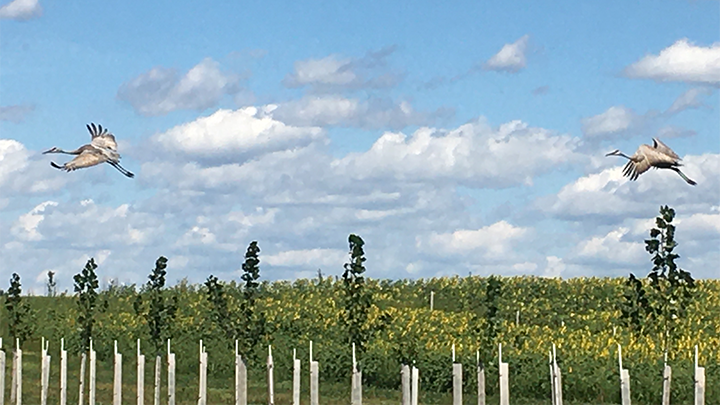
Photo by Margaret Cotter
The habitat created by alley cropping leads to more biodiversity, which brings with it natural defense against the insects, diseases, and weeds that could affect the crop grown between the trees. Alley cropping can be used for silvopasture purposes, providing shade and fodder to livestock who in turn add organic matter to the soil. Wildlife thrive because the trees provide food, cover, and nesting sites for a variety of species.
Alley cropping creates a landscape many people find aesthetically pleasing too. There’s a lot to like about alley cropping.
Is alley cropping in your future?
Alley cropping offers an accessible entry point for some farmers–those who are able to plan for the long term. Alley cropping demands a long-range plan that covers up to 80 years. Farmers will typically begin with income-producing annual crops while the tree rows get established. As the trees grow, the alleys shrink, at which point the trees should be producing income. It’s not uncommon for farmers to move animals into the field at that point.
For people with land they are considering putting into alley cropping, there are a number of decisions, and the Savanna Institute is ready to help. Michele observed, “you would need to know what equipment you have available or could purchase. You would need to know what soil types you have, in order to know what types of trees you can plant. You need to understand the landscape–will you need a windbreak? Do you need to take precautions to prevent pesticide drift? What type of irrigation will you have?”
Fortunately, the Savanna Institute offers Technical Service Providers who are trained to visit your land and walk you through a design. “If you’re ready to get started, we’ll help you connect with all the types of resources,” Michele said. “There is federal and state funding available to help you get started with agroforestry on your land.”
Visit the Savanna Institute website for a wealth of resources about agroforestry: https://www.savannainstitute.org/resources/
By Sarah White

